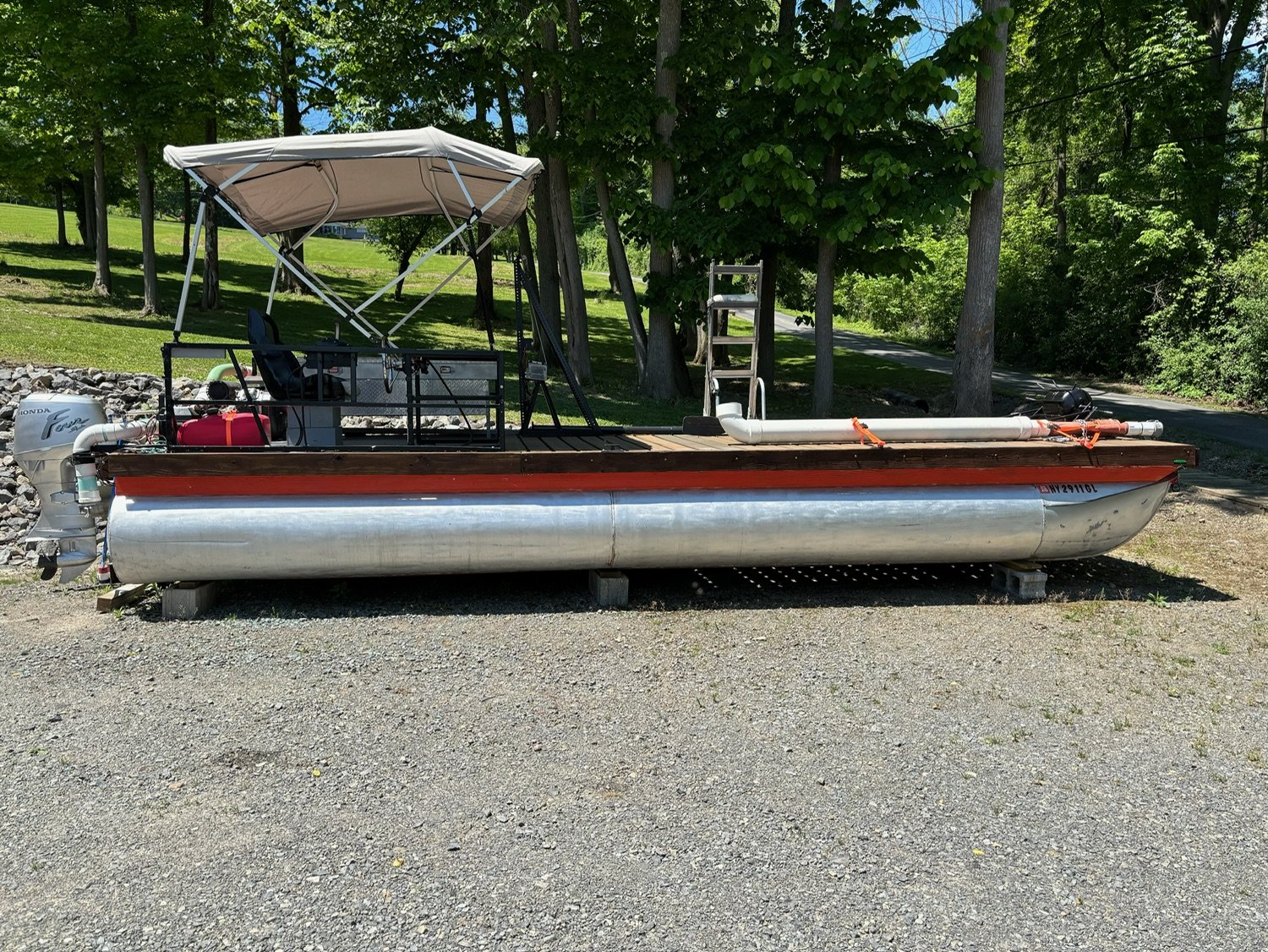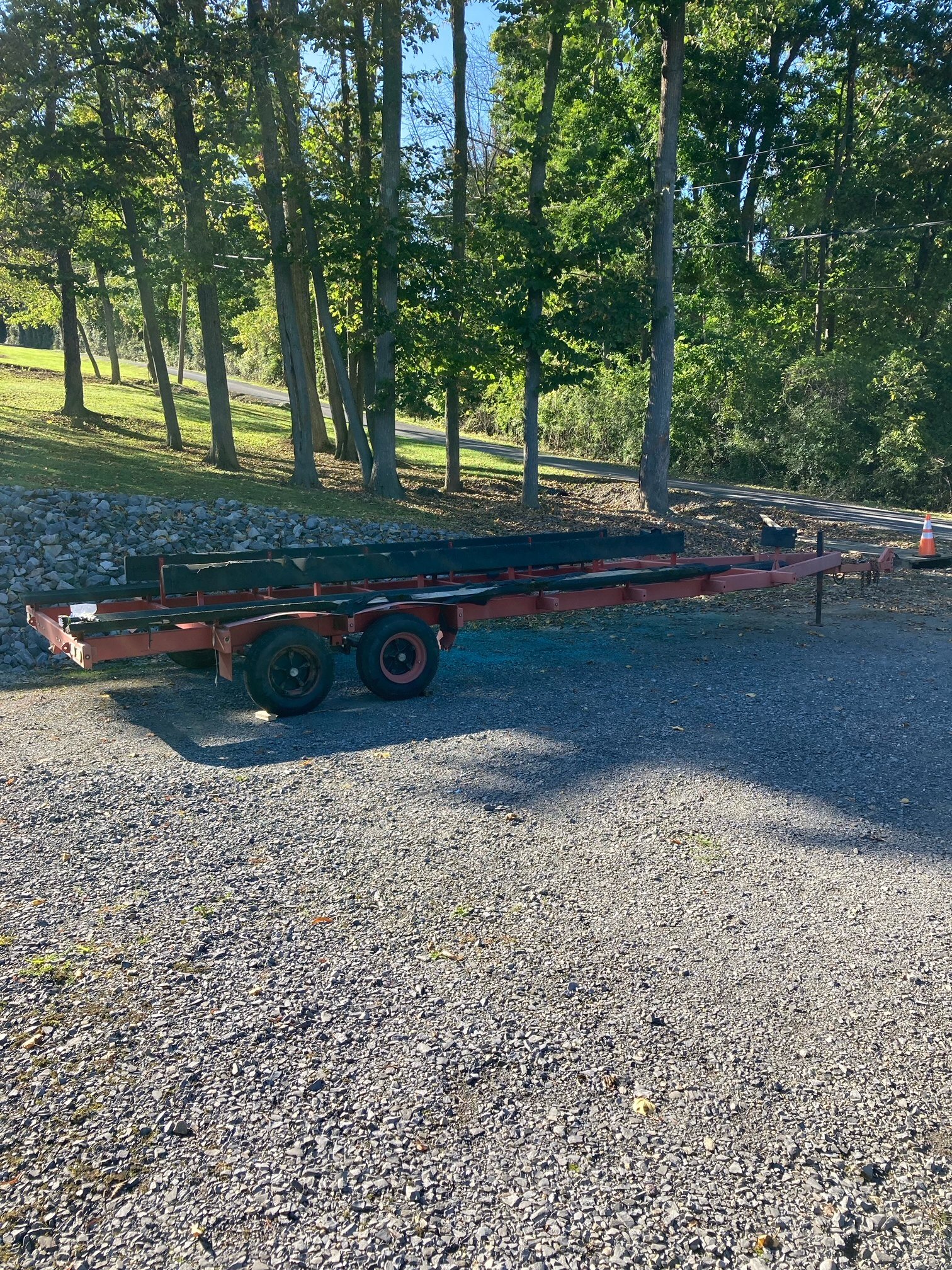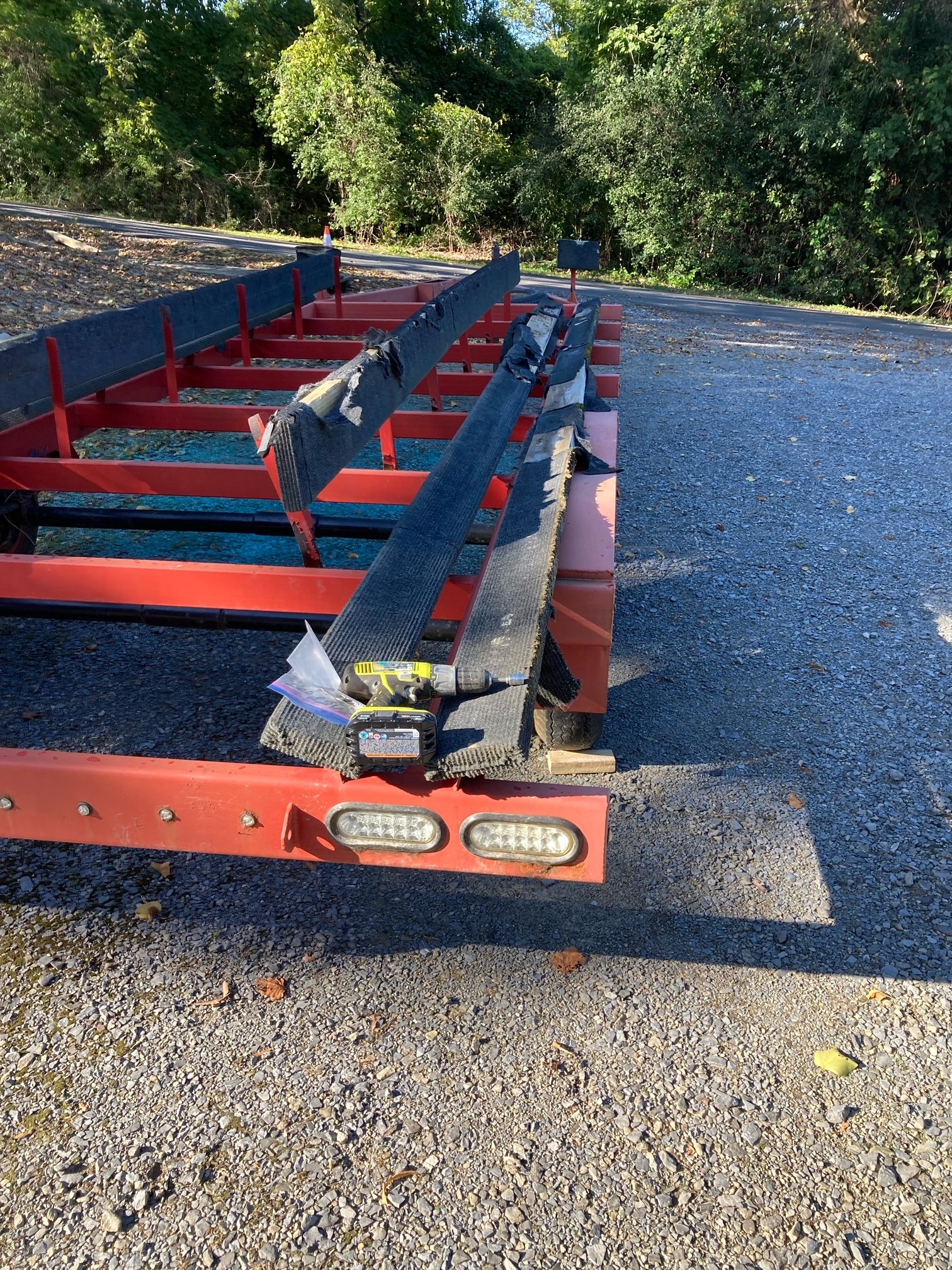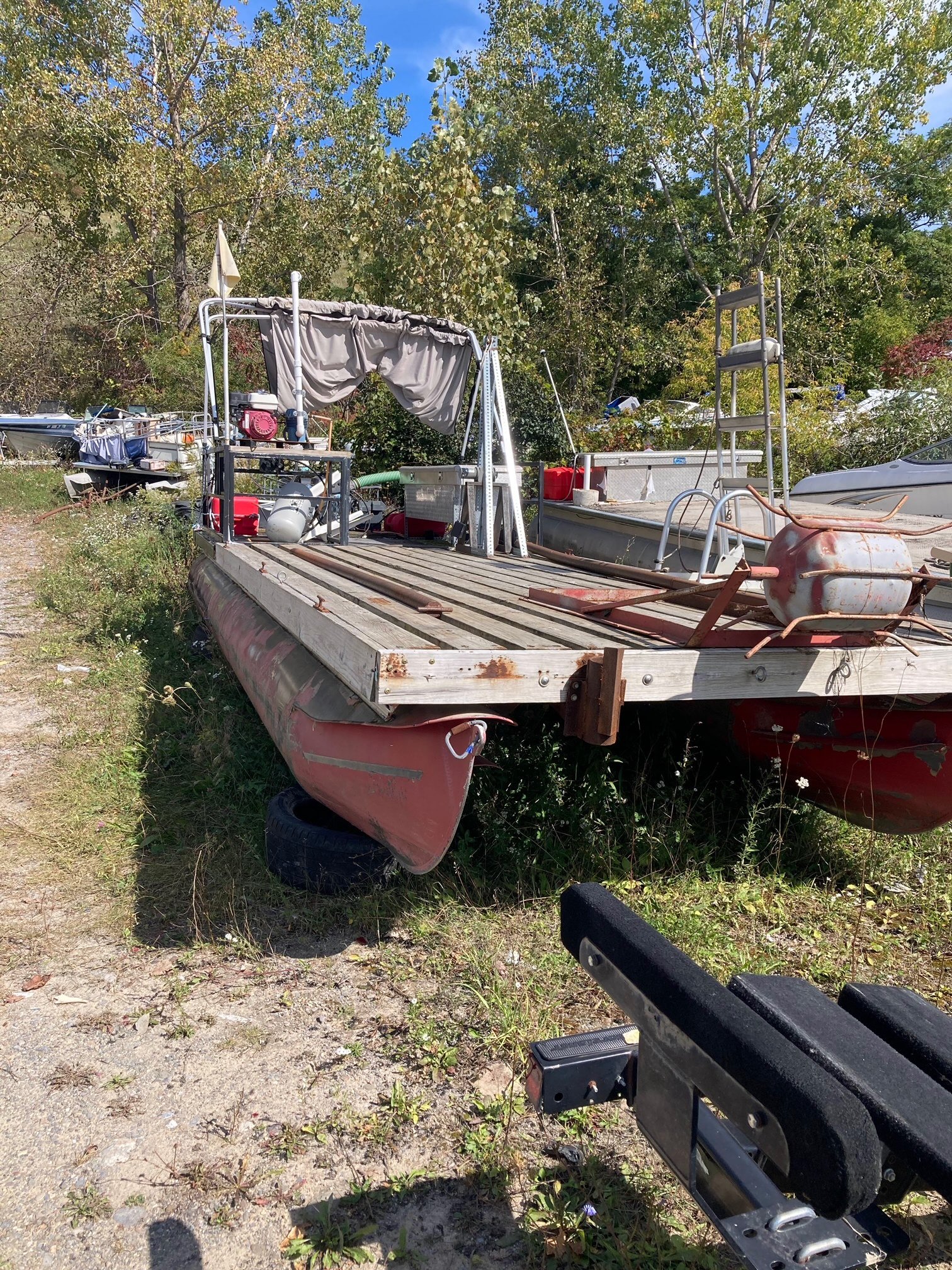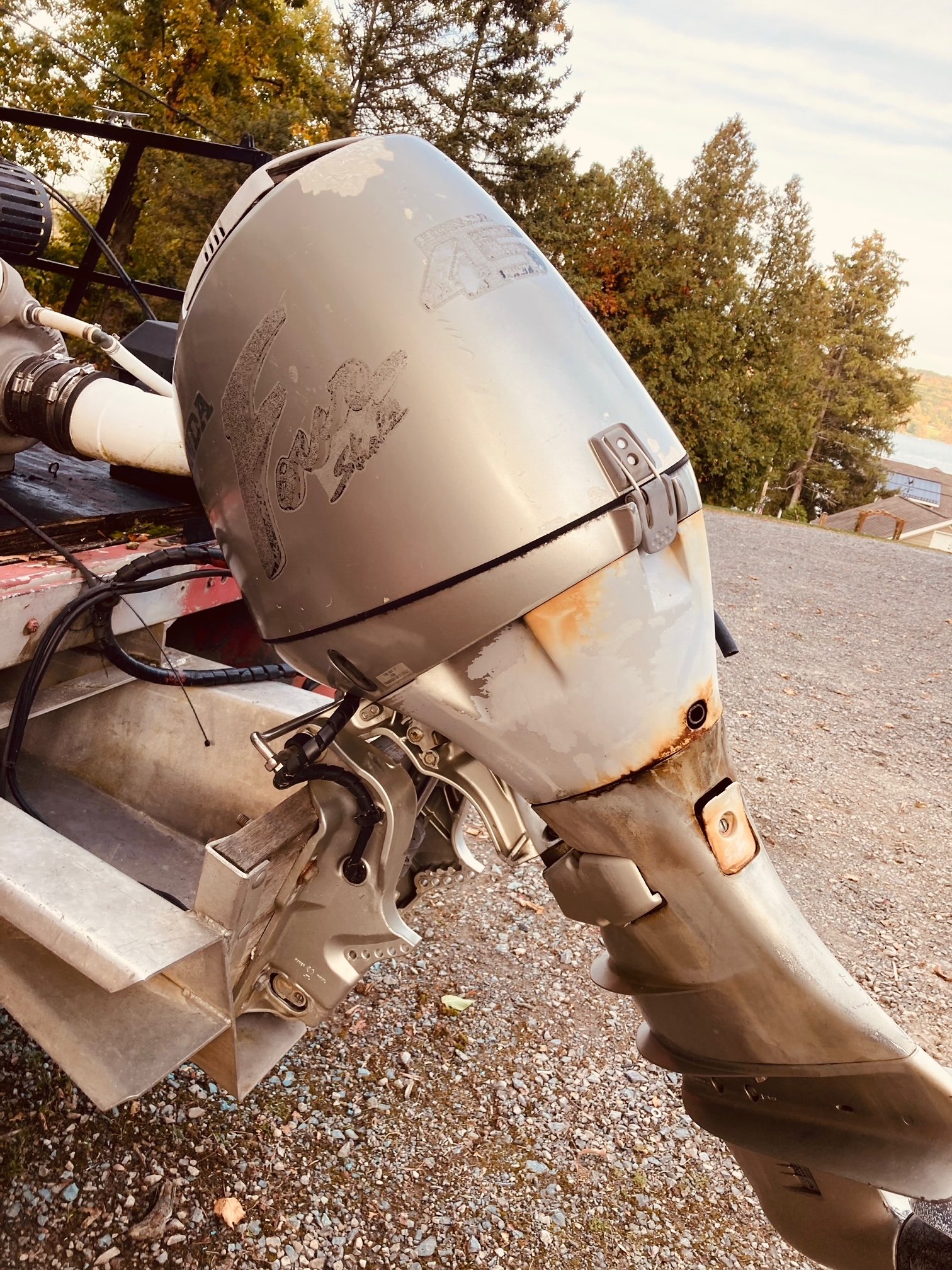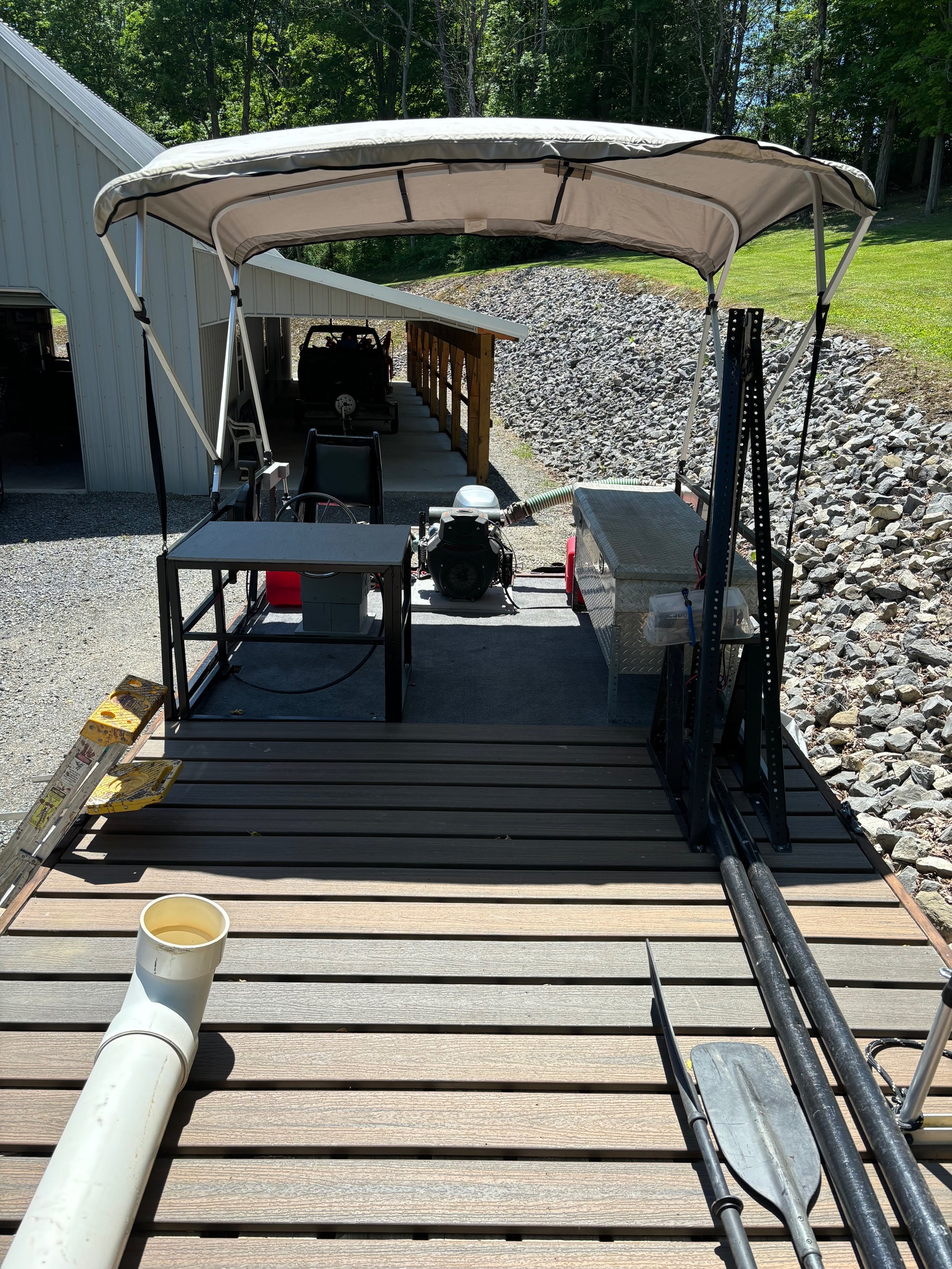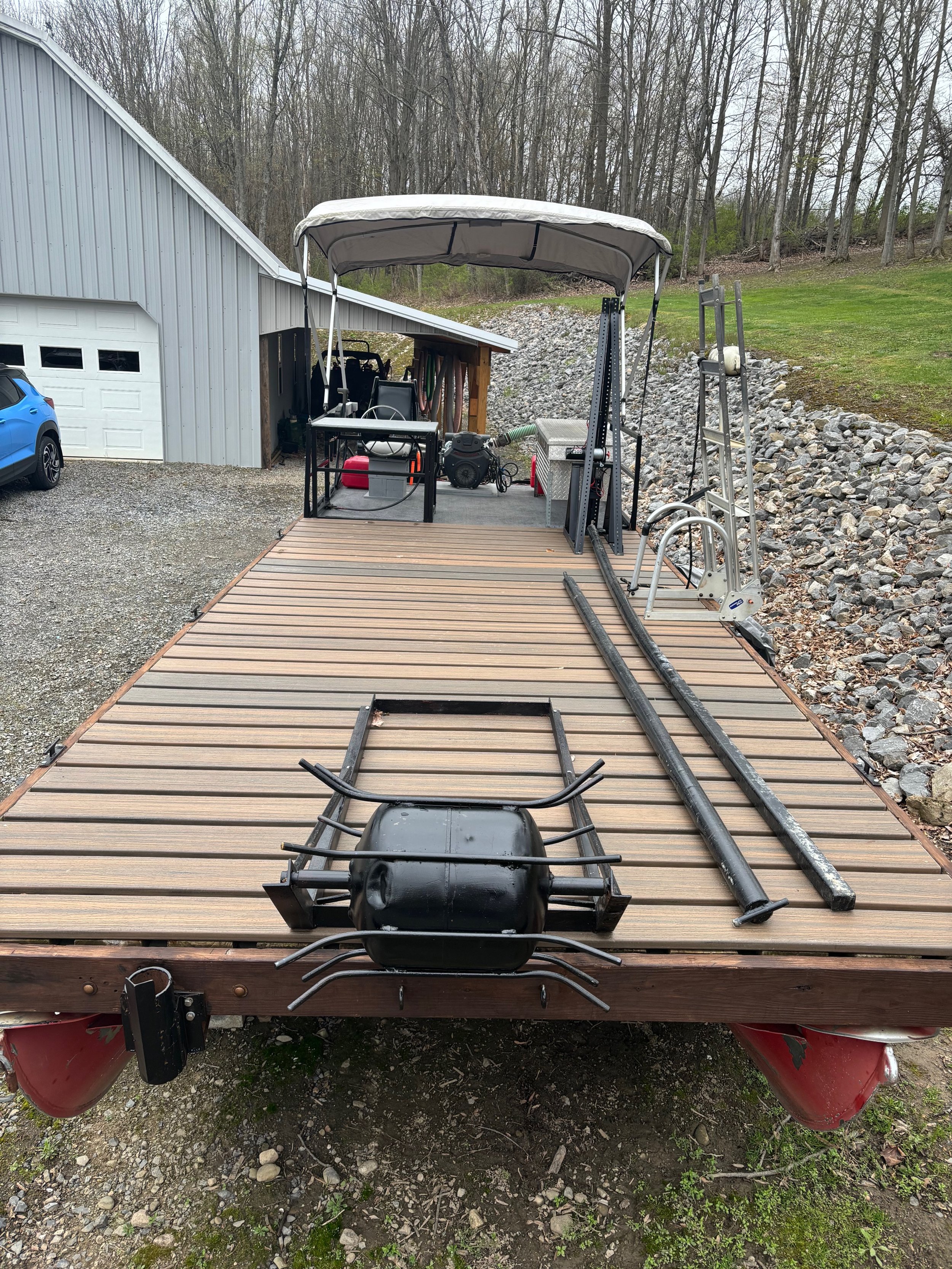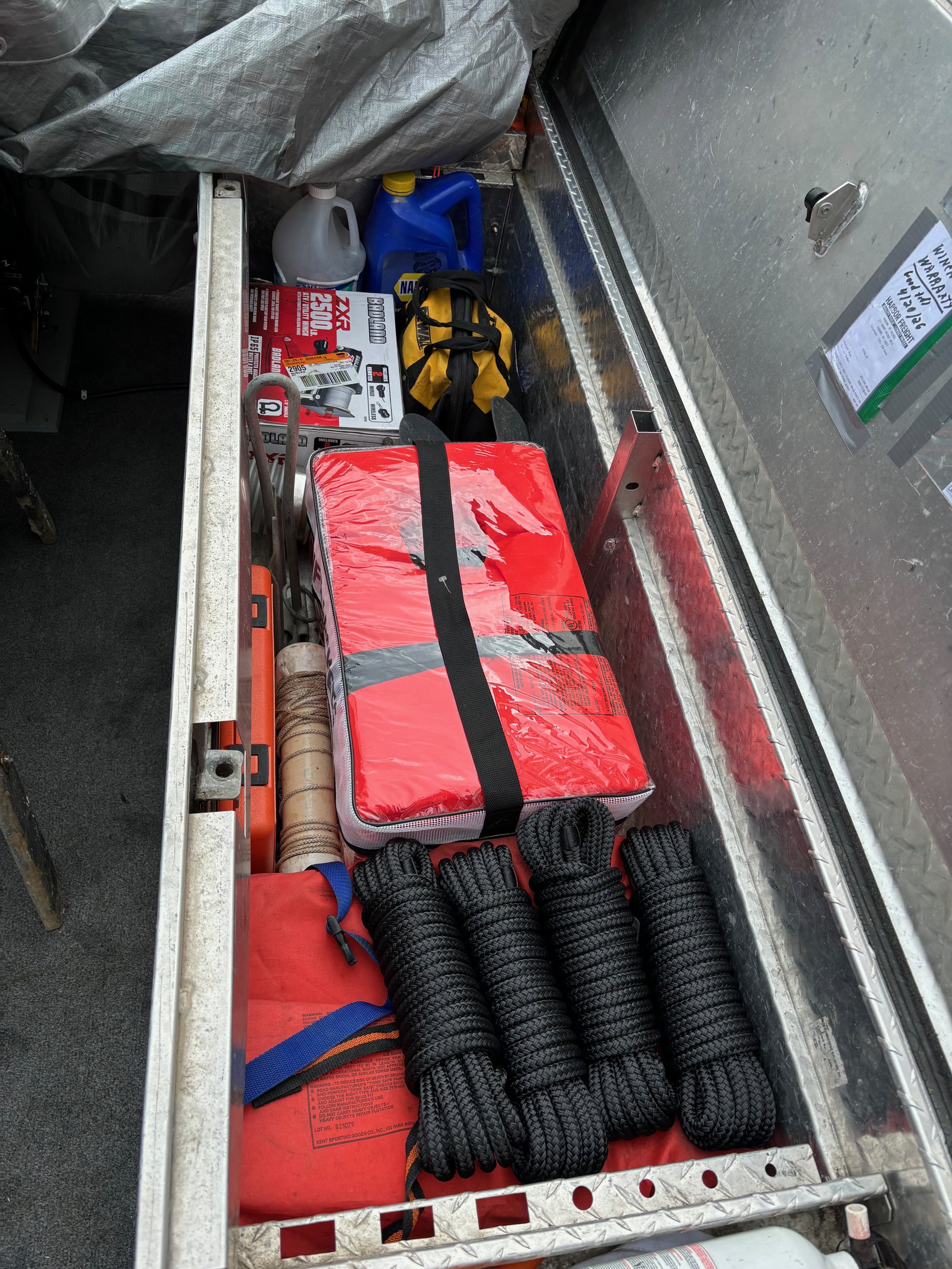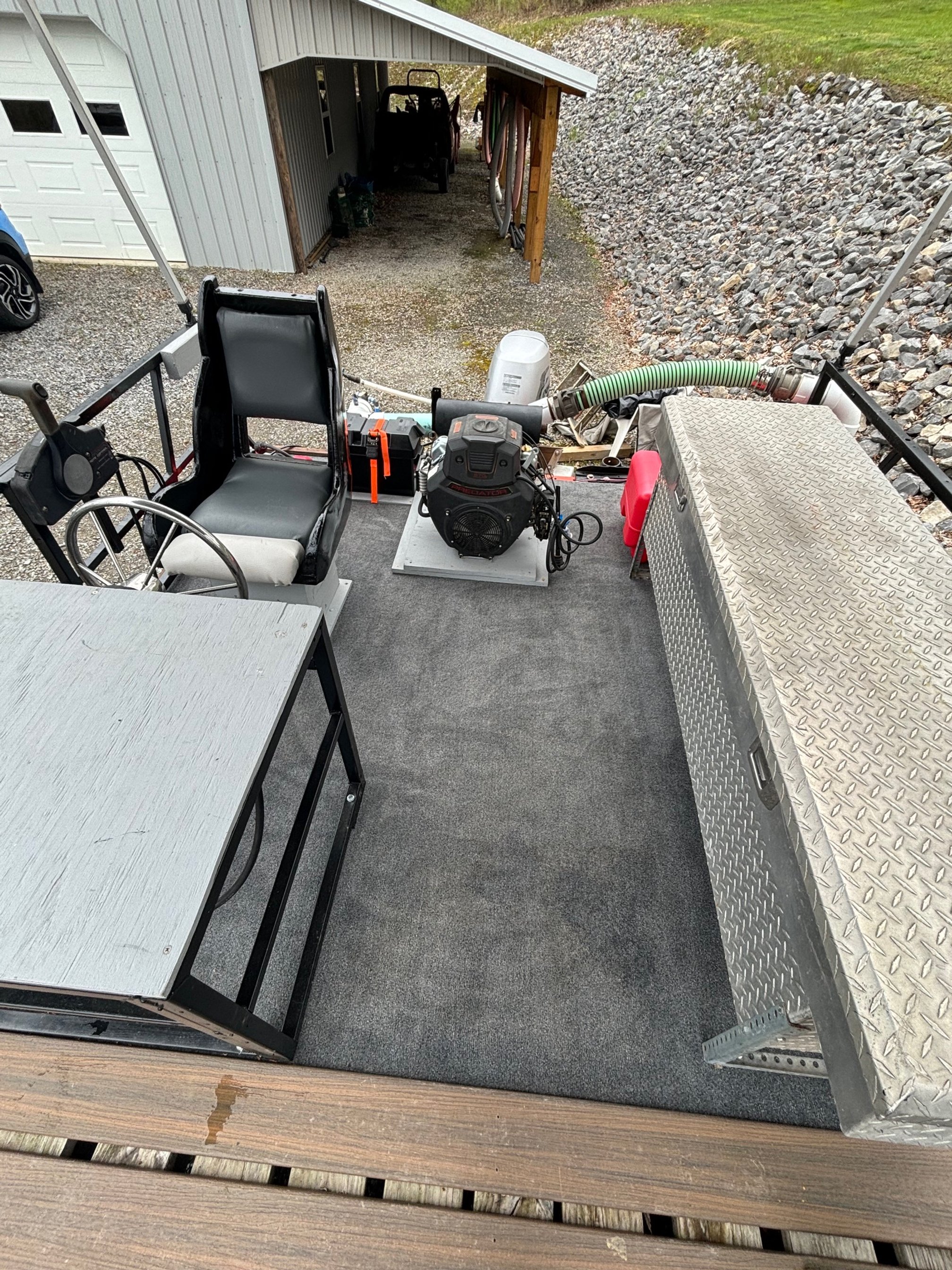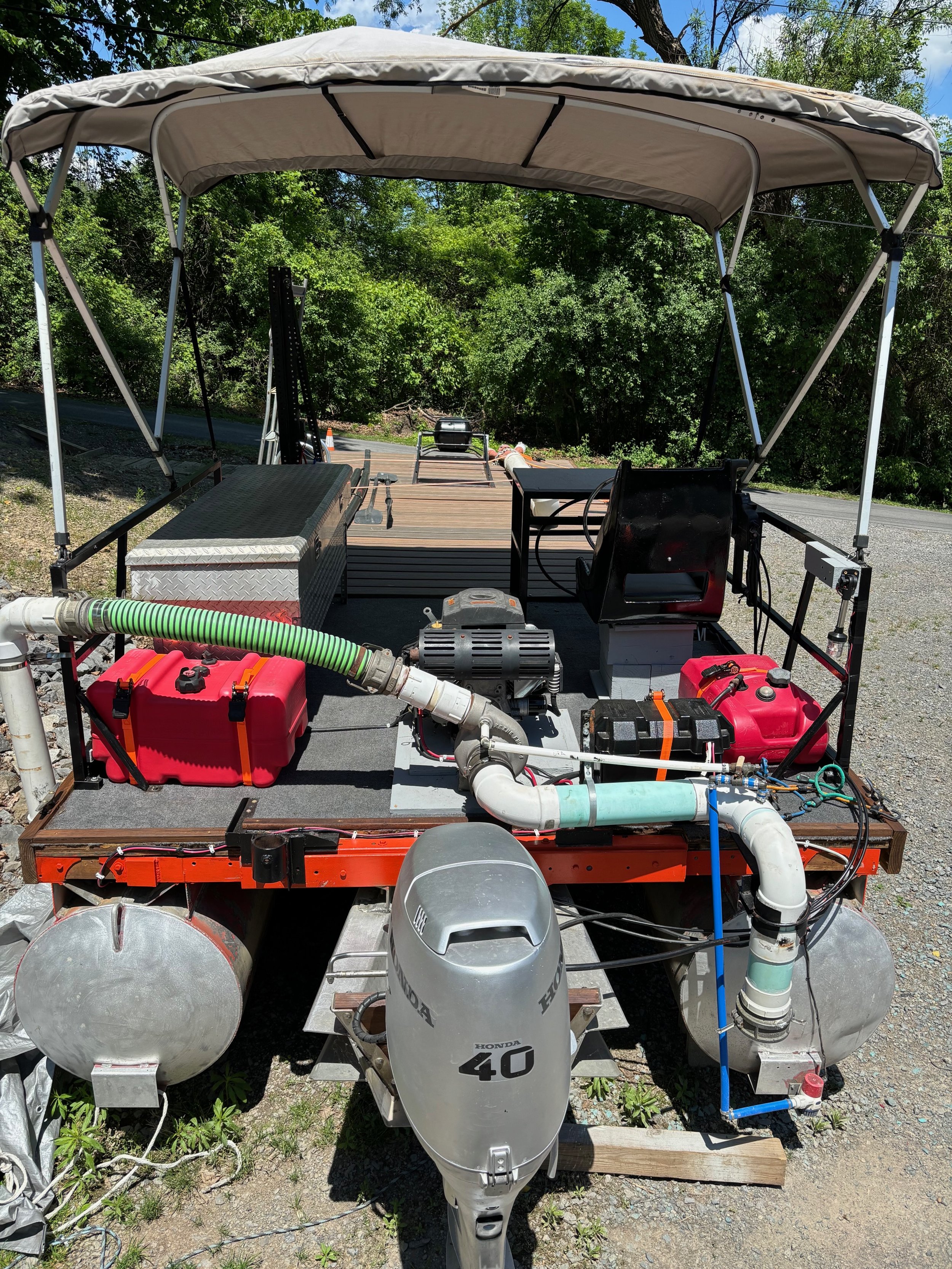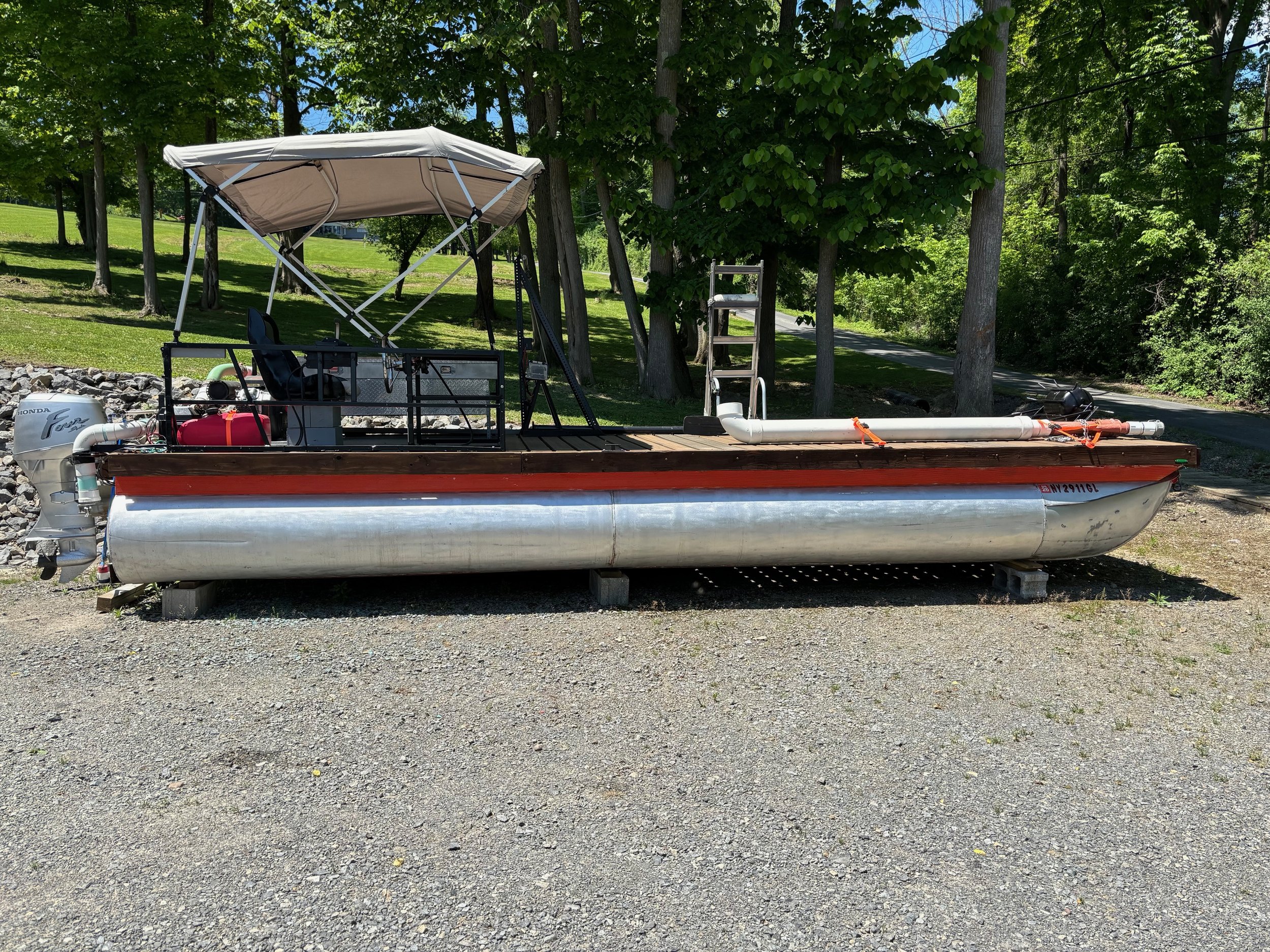THE HISTORY OF THE BARGE
In 2023, the Otisco Lake Preservation Association made a command, if not controversial decision, to purchase a 24' pontoon boat and trailer previously used to remove seaweed from Otisco Lake. The purchase was motivated by the poor state of the lake relative to seaweed infestation, and the vision of a number of people dedicated to saving the lake. The pontoon boat /barge was in a sad state of repair, and a lot of work was needed to renovate it and get it back to a decent, safe and functioning vessel.
Around September, 2023, the trailer was moved to a spot in front of Bill Walsh's barn, after he volunteered to begin the renovation. Two weeks was spent sanding the trailer, an old converted mobile home trailer from the 80s. The bunks were removed, stripped of the old carpeting, and new carpeting stapled to the old 2'x6' pressure treated bunks, which fortunately were still in decent shape. The trailer was painted Kubota orange, as Bill had a leftover gallon from painting his tractor several years ago. The starboard vertical bunk had previously been crushed when the barge apparently swung on the trailer while being loaded. John Kula, a shop teacher at Moravia High School, and a skiing buddy of Bill's, brought his torch over from his home in Union Springs. The collapsed vertical angle irons were heated with the torch and then bent back to their original upright positions, and the vertical bunk re-installed.
The bearings for the wheels were in bad shape, and during replacement it was noted that there were only two shoes remaining from the original electric brakes.
It was also noted that there was no functioning brake system for the trailer, nor were there operational running lights. There was also no registration for the trailer, as it was a homebuilt.
Given the price of adding a brake system and installing new lights, it was decided that the trailer would only be used to store the boat during the off season. Following the restoration of the trailer it was moved to O.C.W.A.’s property at the dam where it will remain for the foreseeable future..
The barge was then transported to Bill's barn, where its restoration began. The barge is 24' in length and 8' in width, the forward 16' being the working deck, and the aft 8' housing the helm, aluminum storage unit, 22hp Predator motor, water pump, hoss, gas tank for the Predator and another for the 40 hp Honda motor that powers the barge, as well as the side gates and bimini. There is also a metal stand which houses the winch to pull the mats on board, as well as a spiked drum, "the Spider", which assists in pulling the mats onto the deck. The Spider is removed when putting the mats into the lake, and re-installed when they are retrieved at the end of the season.
The barge had good bones, and was structurally very sound. But that was the best that could be said of it at the start of the renovation. The working deck was covered by 16 foot 2'x6's, that ran longitudinally along the deck. Unfortunately, the gaps between them were not consistent, nor safe. The gaps ranged from 1' to 2 1/2', and would have been a real hazard to any crew members. Steve Syron, of Erie Materials, was kind enough to donate 16 Trex deck boards, 16' in length. They were cut in half and installed crosswise to the existing deck boards, and spaced evenly. Not only are they aesthetically pleasing, but but they are extremely durable and safe. It was discovered during the Trex installation that the 2'x6' deck sides (16' long) were only held on by three 2" deck screws. They were removed and replaced by 3" lag screws, which really reinforced and strengthened the deck.
It was agreed that the peeling red paint on the pontoons was an absolute eyesore. The only way to effectively remove the paint was by sanding, an arduous and time consuming endeavor. Fortunately there was a compressor in the barn, and through the use a pneumatic sander, and the able assistance of Rick Brown and others, the ugly red paint was removed and a nice shiny aluminum pontoon exposed. While walking on the rear deck, it was discovered that the plywood under the old carpet was totally rotted out and had to be removed. This involved completely stripping everything from the rear deck, and tearing off the rotted plywood. Once removed, the aluminum cross support members had to be trimmed to allow for the installation of new 2'x6's on the sides of the rear deck. New 2'x4's had to be mated to the aluminum cross members to enable the new decking to be screwed down. This required someone with a woodworking proficiency and Mike Cahill, an accomplished carpenter, came to the rescue. Two sheets of treated plywood were installed crosswise, and two larger sheets were installed over them in the opposite direction. The rear deck is now just as strong as the front deck. New 2'x6' sides were added to the rear deck, and again, 3" lag screws were used to secure them. Lorinda O'Brien helped with with the carpentry and installation of the mooring cletes when she wasn't running errands to the Home Depot for supplies.
The Predator motor would not start, and so was taken over to Bobby Heath to get it running. He did so, and was very gracious with what he charged for the parts and his labor. The oxygen system for the divers was removed and discarded as it was a true liability, not to mention that it didn't work. The Honda motor was removed from the boat, as it had been quite neglected and needed attention. It was stripped down, sanded and painted, and a new decal kit added. It looks almost brand new.
When the Honda motor was removed, it was discovered that the transom was thoroughly rotted. New 2'x8' pressure treated lumber was cut and placed and then bolted on with stainless steel bolts. It is now exceptionally strong. The barge had an old white plastic chair for the helm. Precision Marine donated an old ski boat Captain's chair, which was stripped, painted and reupholstered, and a new seat platform attached. About that time the weather closed in, and as it was too cold to install the new carpeting, as the glue required two days above 60 degrees to cure, work was suspended until spring.
Work resumed on the barge the first week of April. Three warm days allowed the installation of the carpeting. With the new carpeting installed, the side braces, aluminum storage unit, helm, gas tanks, Predator motor and pump, hoses etc. were re-installed. New LED running lights (there were none previously) were installed along with a new winch with remote. The wire for the winch was removed and a synthetic rope installed in its place to prevent wire abrasion cuts to the crew, and a switch panel added to the helm to tie all the wiring together. Mike Grome donated thicker wire for the winch, as the distance to the battery required such. Winch tie downs were added to secure the battery and the gas tanks. The bimini was then installed after some repairs. The new pressure treated sides and transom were then stained to match the forward sides. The aluminum storage box now hosts all the necessary safety equipment and lines, extra parts and tools. The Honda motor was bolted to the new transom, and after some coaxing, fired up and ran as it should.
The barge is now ready to go to work. It is strong, safe and seaworthy. But it needs volunteers to run it and operate the equipment and to bring back our lake to the pristine one that it once was.
Think about it, and if you have the time and inclination, you could not find a better organization to be a part of. The spirit and comraderie of the members will be a reward all by itself.
More on the Barge….
Around September, the trailer was moved to a spot in front of Bill Walsh's barn, after he volunteered to begin the renovation. Two weeks was spent sanding the trailer, an old converted mobile home trailer from the 80s. The bunks were removed, stripped of the old carpeting, and new carpeting stapled to the old 2'x6' pressure treated bunks, which fortunately were still in decent shape. The trailer was painted Kubota orange, as Bill had a leftover gallon from painting his tractor several years ago. The starboard vertical bunk had previously been crushed when the barge apparently swung on the trailer while being loaded. John Kula, a shop teacher at Moravia High School, and a skiing buddy of Bill's, brought his torch over from his home in Union Springs. The collapsed vertical angle irons were heated with the torch and then bent back to their original upright positions, and the vertical bunk re-installed.
The bearings for the wheels were in bad shape, and during replacement it was noted that there were only two shoes remaining from the original electric brakes. It was also noted that there was no functioning brake system for the trailer, nor were there operational running lights. There was also no registration for the trailer, as it was a homebuilt. Given the price of adding a brake system and installing new lights, it was decided that the trailer would only be used to store the boat during the off season. Following the restoration of the trailer it was moved to O.C.W.A.’s property at the dam where it will remain for the foreseeable future.
The barge was then transported to Bill's barn, where its restoration began. The barge is 24' in length and 8' in width, the forward 16' being the working deck, and the aft 8' housing the helm, aluminum storage unit, 22hp Predator motor, water pump, hoss, gas tank for the Predator and another for the 40 hp Honda motor that powers the barge, as well as the side gates and bimini. There is also a metal stand which houses the winch to pull the mats on board, as well as a spiked drum, "the Spider", which assists in pulling the mats onto the deck. The Spider is removed when putting the mats into the lake, and re-installed when they are retrieved at the end of the season.
The barge had good bones, and was structurally very sound. But that was the best that could be said of it at the start of the renovation. The working deck was covered by 16 foot 2'x6's, that ran longitudinally along the deck. Unfortuanely, the gaps between them were not consistent, nor safe. The gaps ranged from 1' to 2 1/2', and would have been a real hazard to any crew members. Steve Syron, of Erie Materials, was kind enough to donate 16 Trex deck boards, 16' in length. They were cut in half and installed crosswise to the existing deck boards, and spaced evenly. Not only are they aesthetically pleasing, but but they are extremely durable and safe. It was discovered during the Trex installation that the 2'x6' deck sides (16' long) were only held on by three 2" deck screws. They were removed and replaced by 3" lag screws, which really reinforced and strengthened the deck.
It was agreed that the peeling red paint on the pontoons was an absolute eyesore. The only way to effectively remove the paint was by sanding, an arduous and time consuming endeavor. Fortunately there was a compressor in the barn, and through the use a pneumatic sander, and the able assistance of Rick Brown and others, the ugly red paint was removed and a nice shiny aluminum pontoon exposed. While walking on the rear deck, it was discovered that the plywood under the old carpet was totally rotted out and had to be removed. This involved completely stripping everything from the rear deck, and tearing off the rotted plywood. Once removed, the aluminum cross support members had to be trimmed to allow for the installation of new 2'x6's on the sides of the rear deck. New 2'x4's had to be mated to the aluminum cross members to enable the new decking to be screwed down. This required someone with a woodworking proficiency and Mike Cahill, an accomplished carpenter, came to the rescue. Two sheets of treated plywood were installed crosswise, and two larger sheets were installed over them in the opposite direction. The rear deck is now just as strong as the front deck. New 2'x6' sides were added to the rear deck, and again, 3" lag screws were used to secure them. Lorinda O'Brien helped with with the carpentry and installation of the mooring cletes when she wasn't running errands to the Home Depot for supplies.
The Predator motor would not start, and so was taken over to Bobby Heath to get it running. He did so, and was very gracious with what he charged for the parts and his labor. The oxygen system for the divers was removed and discarded as it was a true liability, not to mention that it didn't work. The Honda motor was removed from the boat, as it had been quite neglected and needed attention. It was stripped down, sanded and painted, and a new decal kit added. It looks almost brand new.
When the Honda motor was removed, it was discovered that the transom was thoroughly rotted. New 2'x8' pressure treated lumber was cut and placed and then bolted on with stainless steel bolts. It is now exceptionally strong. The barge had an old white plastic chair for the helm. Precision Marine donated an old ski boat Captain's chair, which was stripped, painted and reupholstered, and a new seat platform attached. About that time the weather closed in, and as it was too cold to install the new carpeting, as the glue required two days above 60 degrees to cure, work was suspended until spring.
Work resumed on the barge the first week of April. Three warm days allowed the installation of the carpeting. With the new carpeting installed, the side braces, aluminum storage unit, helm, gas tanks, Predator motor and pump, hoses etc. were re-installed. New LED running lights (there were none previously) were installed along with a new winch with remote. The wire for the winch was removed and a synthetic rope installed in its place to prevent wire abrasion cuts to the crew, and a switch panel added to the helm to tie all the wiring together. Mike Grome donated thicker wire for the winch, as the distance to the battery required such. Winch tie downs were added to secure the battery and the gas tanks. The bimini was then installed after some repairs. The new pressure treated sides and transom were then stained to match the forward sides. The aluminum storage box now hosts all the necessary safety equipment and lines, extra parts and tools. The Honda motor was bolted to the new transom, and after some coaxing, fired up and ran as it should.
The barge is now ready to go to work. It is strong, safe and seaworthy. But it needs volunteers to run it and operate the equipment, to place and retrieve the mats, and to do what is required to bring back our pristine lake that it once was. Think about it, and if you have the time and inclination, you could not find a better organization to be a part of. The esprit and comraderie of the members will be a reward all by itself.


